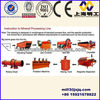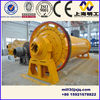- Mine Mill[10]
- Mineral Separator[10]
- Crusher[10]
- Sand Washer[2]
- Conveyors[5]
- Cement Making Machinery[1]
- Drying Equipment[10]
- Contact Person : Ms. Yang Phoebe
- Company Name : Shanghai Minggong Heavy Equipment Co., Ltd.
- Tel : 86-021-59515366
- Fax : 86-021-59515366
- Address : Shanghai,Shanghai,No 33, Shenxia Road, Malu Town, Jiading Zone, Shanghai
- Country/Region : China
- Zip : 201818
Rod Mill
Rod Mill
Rod Mill Introduction:
Rod mill is widely applied in metal and nonmetal mine, water conservancy, glass and construction
materials industries, mainly suitable for grinding various ores and rocks and artificial sand-making.
Our high-efficiency rod mill adopts rolling bearing support instead of sliding bearing support with bearing bush. Therefore, it has advantages of even discharging size and high capacity.
Rod mills are very similar to ball mills, except they use long rods for grinding media. The rods grind the ore by tumbling within the mill, similar to the grinding balls in a ball mill. To prevent the conditions leading to rod charge tangling.. Grinding action is by line contact between the rods extending the length of the mill. Rods tumble and spin in roughly parallel alignment simulating a series of roll crushers. This results in preferential grinding of coarse material and minimizes production of slimes.
Of the three main types of rod mill, overflow, end peripheral discharge, and center peripheral discharge only the overflow mill is in common usage. Wet grinding rod mills are normally used in the mineral processing industry. Dry grinding is used in some areas; however, it is confronted with problems and should be avoided except where absolutely necessary. Rod mills operate at lower speed than ball mills since the rods are rolled and not cascaded. For an equivalent grind, a rod mill uses less steel than a ball mill because of the lower speed and better contact between the media and ore. The rod charge must be maintained in good working condition, and broken and worn rods must be removed. Rod mills usually require greater operator attention. It is important that the rods stay essentially parallel to one another. If rods become misaligned, grinding action is lost and, more importantly, rod tangles occur. Maximum rod length is limited to about 6.1 m (20 ft). This in turn limits the length, diameter, and capacity of rod mills. The heavier rods acting upon the lifters and liners result in greater wear on the mill liners.
Rod Mill Features
1.It is an efficient tool for grinding many materials into fine powder.
2.Popular in building material, and chemical industry.
3.Can be utilized both dry and wet.
4.Because the barrel rotates, the material is crushed involving the individual pieces of grinding media that mix and crush the merchandise into fine powder over a period of hrs.
5.The longer the mill runs, the finer the powder will probably be.
6.Our rod mill is widely applied in metal and nonmetal mine, water conservancy, glass and construction materials industries, mainly suitable for grinding various ores and rocks and artificial sand-making.
Main Technical Parameters
Model | Barrel size (mm) | Effective volume (m³)
| Bar Weight (t)
| Rotating speed (r/min) | Power(kw) | Discharge size (mm) | capacity(t/h) | Weight (t) |
MB0924 | Φ900×2400 | 3.1 | 29 | 22 | 2.5-0.2 | 10-2.9 | 6.6 | |
MB1224 | φ1200×2400 | 6.5 | 27 | 37 | 2.5-0.2 | 13-5 | 13.5 | |
MB1530 | φ1500×3000 | 5.0 | 8 | 23 | 75 | 2.5-0.2 | 12-5.5 | 16.71 |
MB1830 | φ1800×3000 | 6.5 | 17 | 22.8 | 130 | 2.5-0.2 | 20-9.5 | 29.8 |
MB2136 | φ2100×3600 | 11.0 | 28 | 20.9 | 210 | 2.5-0.2 | 35-14.8 | 49.4 |
MB2436 | φ2400×3600 | 14.6 | 37 | 19 | 280 | 2.5-0.2 | 55-26 | 61.0 |
MB2740 | φ2700×4000 | 20.5 | 47 | 17.5 | 400 | 5-0.8 | 165-50 | 84.3 |
MB3040 | φ3000×4000 | 25.9 | 50 | 16.2 | 500 | 5-0.8 | 206-62 | 130 |
MB3245 | φ3200×4500 | 33 | 56 | 15.5 | 630 | 5-0.8 | 228-70 | 138 |
MB3654 | φ3600×5400 | 50 | 94 | 14.5 | 1000 | 5-0.8 | 340-103 | 192 |
Rod Mill










